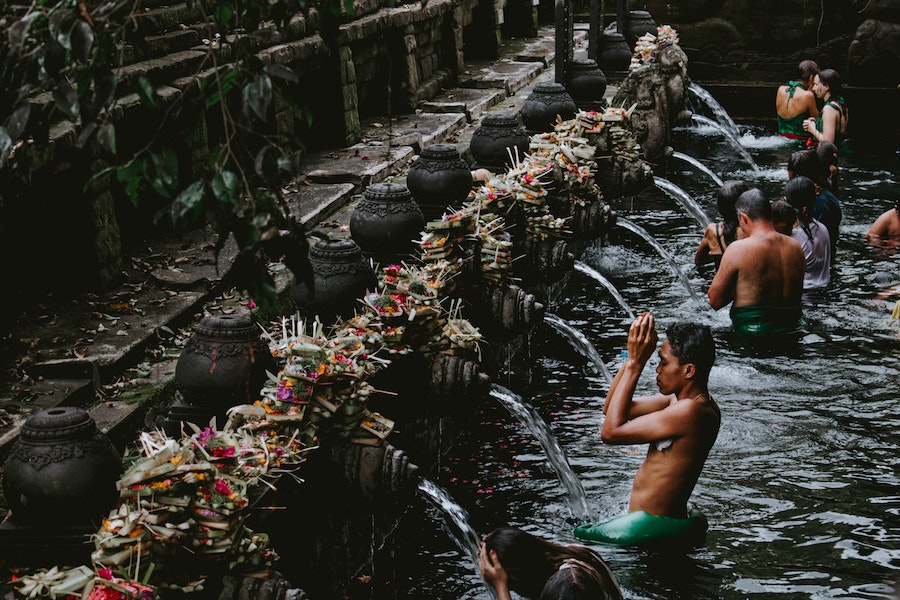Agama Tirta , the Religion of Water. This is what Balinese religion was often referred to before it’s official title of Hindu Dharma, as water was – and continues to be – an essential element in the rituals and even belief of the Balinese.
Today’s episode is taken from one of Jean Couteau’s articles in the NOW! Bali archives, titled Balinese Pilgrims on the Quest for Holy Water (full transcript below).
Listen to Episode 17:
Available on your preferred Podcast Platform:
iTunes • Spotify • Google Podcasts • Pocket Casts • Radio Public
Agama Tirta – TRANSCRIPT:
Most religions of the world use water and fire as purifying elements. Water cleans, soothes and fertilises, while fire heats, destroys, and thus cleans too. Water and fire are a part and a parcel of the rituals of religious life and, once in a while, of the political games of men of religion.

Bali is no exception. Fire is the god Brahma, while water is Wisnu. They are one in ecology and cosmology: the fire of the mountain is next to the water of the lake and of the sea. They are one in rituals too: the fire offering is sprinkled with holy water, and the vessel is cleansed from the smoke of the holy fire.
But, whatever the role of fire, Bali is a culture of “fertility” and of water. Before being called Hindu Dharma, or Hinduism, the Balinese religion was commonly called Agama Tirta, or the religion of water. This name bore witness not only to the role of water in rituals, but also to its role in the ecology of the island. The whole ecological system of Bali is linked to the availability of mountain water and its adequate distribution to the elaborate irrigation system of the island.
Water, in Agama Tirta, thus embodies not only symbolic, but real fertility as well. It also relates to the godly, as the gods and ancestral deities are said to be dwelling in the mountain heights. The dead ancestors are even said to “become water”: “suba dadi yeh and incarnation is even said to be the “drop” of an ancestral soul.
Many of the rituals in Bali address, in various combinations, the two main aspects — real and symbolic — of the role of water. The Balinese ask for “holy” water nunas tirta during temple festivals, weddings, exorcisms, death ceremonies, etc. The typical posture of “nunas tirta” is sitting on the ground, hands open.
After the completion of introductory prayers, the priest or priest’s helper comes along, and, standing at a distance, with a long bunch of holy alang-alang grass (lis), he sprinkles the holy water to the faithful who are waiting. As the last person cups his/her hands together, the priest then pours some holy water into the hands, which is then drunk and wiped over the face. After a final prayer, the faithful can stand up and go.
Water for the preparation of the “tirta” holy water is obtained from a variety of places. Most temples have their specific “petirtan” of “pura beji” temple where the priests go, usually in a procession to get the pure water needed for the preparation of the religious events.
Some villages have tens of small shrines next to a river or a spring, each with its own water and its own temple of destination. This water itself has to be “asked” from Wisnu as the Lord of water, and Dewi Danu as the goddess of the lakes.
The place where one gets this pure water varies according to the type of ceremony. For the main ceremonies, one has to go to the higher temples on the physical and symbolical scale of purity, i.e. not at the nearest “pura beji” as above but in a higher and thus “purer” place, for example, at the mountain lakes at the top — although one can also go to the sea to get “tirta segara “ or holy sea water.
As for the faithful, they go through great lengths to get holy water. “Metirta yatra,”or pilgrimages to the sacred places with corresponding holy water, is indeed one of the duties and pastimes of the religious Balinese. For centuries, priests, artists and men of power have thus visited temples reputed for their holy water on top of mountains, in remote forests, or anywhere where a “taksu” power was thought to reside, often with the hope of catching part of that power for their own purposes.
Now, things have evolved from the original ways of Agam Tirta. Religion has become more abstract and transportation has considerably facilitated the visit of far away temples. What took days of travel in the past now takes hours in buses or cars. Most Balinese students now casually visit in turn the higher-up temples – Sad Kahyangan and Dang Kahyangan — that has turned Bali into a symbolic lotus, and thus, into a representation of the world. Others go to the Mandara Giri temple in Java, at the foot of Semeru, the “highest” mountain of Indonesia.
More importantly still, the world itself, in its physical “wholeness” is now within reach of the Balinese, beyond Bali itself, and beyond Indonesia. In the last ten years, the Balinese have learned to locate on the map “rivers” and holy places which they had heretofore only learned of in the religious mantras of their priests and books: Gangga, Yajmuna, Saraswati. They now go there, not only to fetch the holy water for their main rituals, but also on pilgrimage.
Modernity certainly has had its effects on Balinese religion, sometimes in good ways as we see here.
After all, Indonesian Moslems have long been going to Mecca on pilgrimage, while Indonesian Catholics have been going to Lourdes. So why can’t the Balinese Hindu’s pilgrim to the Ganges too?







